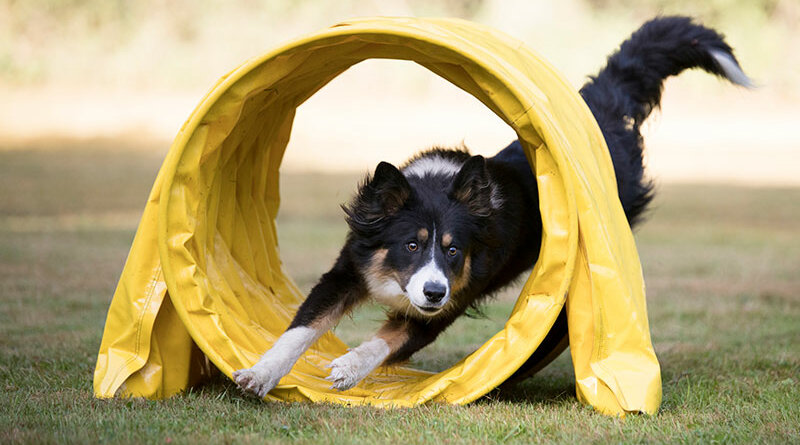Make Your Dog’s Life Better with Canine Enrichment
It’s commonly understood that enrichment provides massive benefits to animals under human care, whether those animals are in zoos, aquaria, shelters or sleeping on our couch. What is far less well known is exactly what “enrichment” means beyond feeding animals in a way that presents challenges to acquiring food or giving them puzzle toys or regular toys to amuse them. While these offerings are certainly important pieces of many enrichment programs, they’re only a fraction of the entire concept of enrichment.
In the 2019 book Canine Enrichment for the Real World: Making It a Part of Your Dog’s Daily Life, authors Allie Bender and Emily Strong note that enrichment can be defined as “meeting all of an animal’s needs as closely as possible to how they would be met in the wild, in order to empower them to engage in species-typical behaviors in healthy and appropriate ways.” This broader approach to enrichment is a welcome development in the dog world, and Bender and Strong’s book has become the go-to resource on the topic.
Like most trainers, behaviorists and shelter staff, I consider this book an indispensable tool in the quest to make our dogs’ lives as fulfilling and happy as possible. Rich in current research, it’s easy to read straight through, and equally useful as a reference. As the authors say, “This book isn’t about our opinions; the goal of this book is to open up for you the whole wide world of information and resources available about who dogs are and how to meet their needs.”
Providing enrichment to our dogs (or to any animal under our care) requires recognizing the importance of natural behaviors to animals’ well-being and placing value on creating opportunities for those natural behaviors to be performed. In the zoo community, where the concept originated, the goal of enrichment is to do what we can do to elicit the natural behaviors of captive animals.
GET THE BARK NEWSLETTER IN YOUR INBOX!
Sign up and get the answers to your questions.
Studies of animals in the wild are made to determine what those specific natural behaviors are for each species and then facilitating their expression. That has been done in a variety of ways: modifying exhibit design, including changes to the structure and temperature; adjusting sensory elements related to lights and sound; providing bodies of water, mud, or branches to climb; offering foraging opportunities that mimic the natural experience; prioritizing social groupings; and so much more.
In the pet world, the concept of enrichment has often been defined more narrowly, recommending play, toys (including feeding toys) and exercise to make dogs’ lives richer and more interesting. Enrichment is so much more than that. If those who love dogs and want to do right by them gained an understanding of all that enrichment really means, dogs’ lives could indeed be significantly improved.
The emphasis on eliciting natural behaviors adds to the concept—and to our dogs’ quality of life—substantially. Dogs have an extensive range of natural behaviors, and many of the items on the list are familiar to us: physical exercise of sufficient quantity and intensity; mental stimulation, such as problem-solving and exploring; digging; barking; chewing; social interactions with both people and other dogs; and sufficient sleep.
Though the book is filled with specific suggestions about enrichment along with detailed explanations that puts them in historical context, I’d like to give a shout out to the following general tips as essential for working toward providing the best enrichment possible for our dogs.
• Ideal enrichment varies by individual as well as by breed. Dogs have different needs in terms of what they enjoy and how much time they want to spend on such activities, including how much time they spend in social contact with others.
• Providing choices to a dog is a great form of enrichment whether those choices are about which way to walk, what to sniff, or whether or not to approach a person. Having some control over their environment and what happens to them prevents dogs from feeling powerless, which in turn can lead to all kinds of negative emotions.
• Physical exercise affects the brain, mood, digestion, memory, appetite, sleep, learning, stress, impulse behavior, depression and anxiety, but not just any physical exercise will do. Some dogs require hard exercise for considerable amounts of time each day while others thrive with shorter, gentler bouts of physical activity. (Interestingly, the many benefits of exercise are not achieved through forced treadmill exercise.)
• Safety and security are critical elements of enrichment. Providing a spot for refuge that may be used by a dog who needs to relax in a busy household can make a huge difference to many dogs.
• Mental stimulation is an important part of enrichment and can take many forms. Dog sports, play, training, foraging and walks all offer dogs an opportunity to use their brains in beneficial ways.
• Let them be dogs! Dogs typically have a need to engage in the specific activities that they enjoy. The activities may be digging, barking, going on sniffari, sleeping a lot, chewing, foraging or playing. Allowing them opportunities to engage in what comes naturally is a major goal of enrichment. Of course, some behaviors that dogs enjoy—such as digging, barking and chewing—are problematic for owners (and neighbors!) and can even indicate a dog in distress if they are being done to excess. The goal is not unlimited chances to engage in such behaviors, but to create enjoyable and appropriate opportunities to do so.
Enhancing the enrichment plans for our own dogs can make them happier and their lives fuller, and Canine Enrichment for the Real World tells us how.




top online pharmacy india https://indianpharmacy.life/# – buy prescription drugs from india
www canadianonlinepharmacy https://drugsotc.pro/# cheapest pharmacy canada
the dark internet darknet links darknet drug market
Way cool! Some very valid points! I appreciate you penning this article plus the rest of the site is also really good.